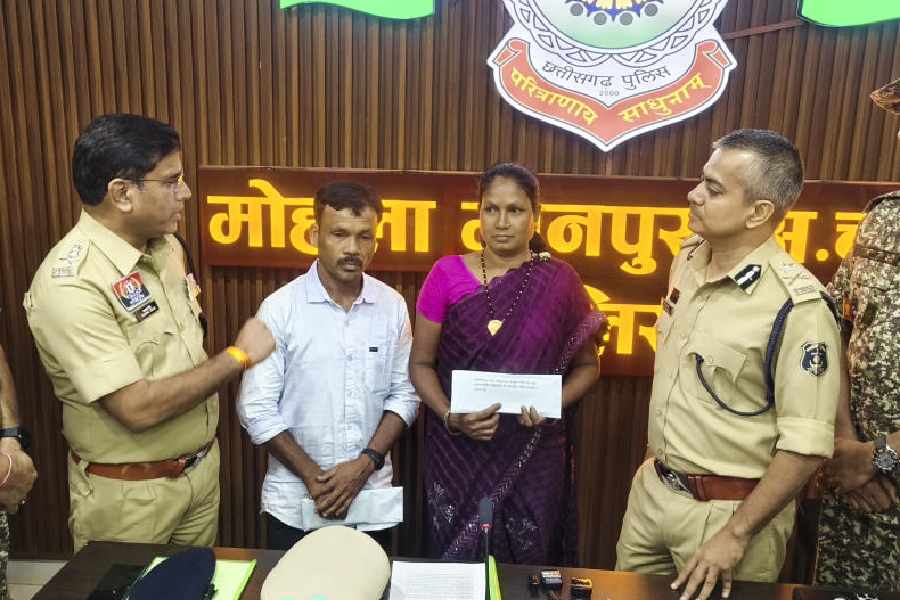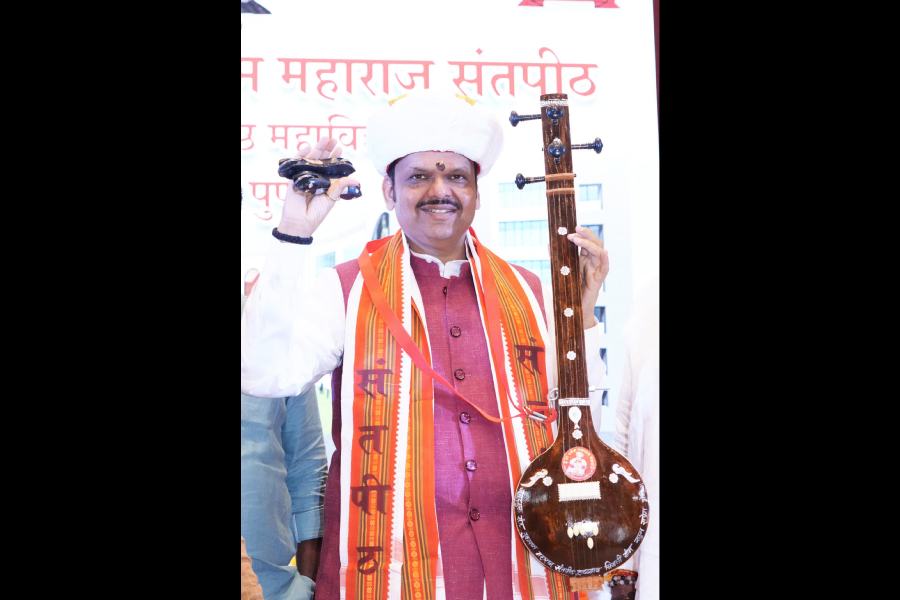 |
A young Mongolian girl, dressed in a short white dress, climbs all the way to the top of a rope and swings her body to and fro. She looks like an angel performing a ballet mid-air. Compared with her, the Indian trapeze artistes look undertrained and outdated, especially because of their age-old “cabaret” costumes.
After a gap of two years, the big top has risen again in the Park Circus maidan. The circus is back. Fresh from a stint in Amtala, the Ajanta Circus has hired a part of the city grounds for 45 days by paying over Rs 11 lakh to the city civic authorities. It is a troupe of 300 performers and workers.
Along with the customary elephant, horse, dog and exotic birds, there is a band of foreign gymnasts, even more exotic — six from Mombasa in Kenya and five Mongolian performers from Ulan Bator. A band of seven from Tashkent has just joined.
The circus has changed. Its traditional Indian part looks worn out, decadent. The foreign elements are professional — all the Mongolian acrobats graduated from the National Dance and Circus School of Mongolia; the Kenyans trained at the “circus college” in their country — and sexy, a treat for adult eyes. East European countries, many of them part of the former USSR, have a tradition of gymnastic and circus training centres. A few African countries have training schools.
Yet the Indian circus continues to exude its own unique charm, almost an innocence, which still brings the city crowds in droves, especially on weekends.
 |
These are trying times for a circus. The big cats have gone after protests from animal rights activists. Children have been seduced by television and technology. In the absence of wild animals, the foreign performers are the biggest attraction in a circus.
“The circus is a sick industry now,” says Ajanta Circus supervisor Khondakar Abu Salem. A major cause is the huge daily expense. “When shows are on daily, the expense is Rs 70,000. When there is no show, it’s still Rs 50,000.”
But despite the drawback of only a few animals, foreign performers and a carefully-decided itinerary, with several small towns and melas on it, keep some circuses a profitable business.
So humouring the foreigners is a new priority, added to the old one of organising each day like a war effort.
Pay packet
The manager of the circus, T. Jairaj, often finds it difficult to communicate with the foreigners, especially the Mongolian girls, as they know neither English nor Hindi.
“On one occasion one of them wanted to eat a particular fruit. We tried our best to understand what it was. Finally we bought picture books on fruits from Park Circus and showed her. She then pointed at a papaya,” says Jairaj.
Apart from ensuring that the Ulan Bator performers get their share of meat, which they are very fond of, for almost every meal and Morris Umgei and Kazungu Lubembe from Mombasa get their “ugali” — boiled suji or ground corn taken with chicken soup or vegetables — the management also has to see that they are happy with the pay.
“Each of the foreigners gets Rs 2,000 a day in addition to Rs 200 as daily food money. But actually they get more than Rs 2,000 a day. Our contract with them is for two daily shows but three shows are being held in Calcutta. They get Rs 1,000 daily for each additional show,” says Khondakar.
 |
In rural areas, a circus is still expected to be a zoo and villagers who bring their children to a circus to show them wild animals like tigers, leopards, lions, bears or hippopotamuses and don’t find them can be an angry lot. “They have no knowledge about government restrictions and hence blame the circus manager for not keeping a stock of wild animals,” says Khondakar.
It is hard to replace the attraction of wild animals. “So we have turned towards foreign performers. We are also planning to bring Sumo wrestlers,” said Khondakar.
The rates for the foreigners work out. For, the circus would spend much more on the procurement and maintenance of the several wild animals that it is no longer allowed to keep. To get foreign performers, the circus management gets in touch with agents.
The Indian performers are far less skilled than the foreigners and some of them look “pathetic”, says a recent visitor to Ajanta Circus, who took his two-year-old son there, and was very happy with the lithe movements of the Kenyan acrobats, but disappointed since the Mongolian stars did not perform that day.
“The Indian artistes performed the same old tricks. Worse, there was nothing funny about the clowns, all of whom were dwarfs. They did not even bother to put on the red nose,” he complained.
It is reflected in the pay scheme, though the management insists that the Indian artistes get not less than Rs 500 every day. The stuntmen who ride high-speed bikes within a miniature globe are the highest-paid performers, says Khondakar.
However, if the foreigners are special, the Indians form the bulk. There are 80 Indian performers, 26 of whom are women.
Food management
Though most of the performers prefer to cook themselves, there are four messes — the management’s mess, the general mess, the performers’ mess and the labourers’ mess. Performers are given meat, chicken and egg daily.
Food for the animals is a much more elaborate scheme. Each elephant — there are four (“there was only an old one,” complained the father of the two-year-old) — is given 12kg of atta, ghee mixed with jaggery and banana leaves. In winter they are given hay stuffed with whole wheat. For, if an elephant does not get food, it starts to show its displeasure with angry trumpets.
Horses are given husk, gram, carrot and bread. Cockatoos and macaws are fed kusum seed, sunflower seed, gram, groundnut, green chilli, apple, grape and maize. They are given multivitamins regularly and during summer, to avoid dehydration, they are given ORS.
“We go to Sonepur, Jaldapara or Kishanganj to get elephants and horses. After procurement it takes not less than two years for an elephant or a horse to become stage-ready,” says Khondakar.
The circus still works for it is a real family entertainment. “That’s why we can’t bring foreign dancers. We have to think of Sumo wrestlers.” An elephant costs Rs 15 lakh, the price of three WagonRs. A Macaw can cost up to Rs 1.5 lakh. A cockatoo costs as much as a horse: about Rs 50,000.
But in a circus the largest investment, says Jairaj, is in iron and steel and cloth. Fire-proof ropes cost Rs 150 a kg. The circus requires around 50,000 square metres of cloth. A metre costs Rs 90.
Moving on
A circus is set up in very little time with the help of all these materials.
“The circus is a self-sufficient unit. A big top covering an area of about 1 lakh square feet is set up by six workers under the command of two tent masters in a week,” says Jairaj. The inventory of electric incandescent lamps a circus maintains is more than the requirement of a small town municipality. “At Ajanta Circus, we have a stock of 1.5 lakh electric bulbs,” he adds. “I think a circus is the place to learn management,” he laughs.
The circus also uses searchlights discarded by ships to make its presence known to distant localities in rural areas.
And then one day the show is over, and the circus must move on. It’s not mere transportation of people and animals. The circus has to pack all that cloth and steel and those electric lamps and generators.
Then like a giant creature, it lifts off and starts off for a new home.
foreign girl in the ring
The foreign performers say they are a happy lot. “We have come to the circus through Asif (an agent) in Delhi and he knows everything. We are happy about the payment,” says Morris Umgei. Kazungu Lubembe, who, like Umgei, can speak English haltingly, is a father of four. He has decided to fly to Mombasa immediately after the expiry of his visa in March as he came to India leaving behind a newborn son.
They don’t send money every month to their families. “When we remain out of the country our relatives take care of our families and we repay them after our return home,” says Umgei.
But both Umgei and Lubembe don’t like to bring their children to the circus. “We are happy but at the same time, we don’t want circus as a career for our children.”
Like Lubembe of Mombasa, Khundaga from Mongolia too would like to fly to Ulan Bator as early as possible. She is an acrobat-cum-dancer in her 20s. “My only dream at this moment is to meet my boyfriend in Ulan Bator.”
She places Calcuttans as viewers in the second position after the Japanese. “In Japan we found spectators shouting “sukai sukai” as we entered the circus arena. In Calcutta we felt overwhelmed when after our performance some people came forward and gave us flowers.”
What did she know about India before coming here? “Nothing, except the song Aa gaya aa gaya, halwawala aa gaya. It is a favourite song. I saw the movie (Mithun’s Dance Dance) on a CD in Ulan Bator and it often brought tears to my eyes.”
The leader of the Mongolian team, Jorj, a master acrobat, now plays a clown. Why? “I am 32 and not fit enough to take part in an acrobatic show. In our school a student learns everything from performing as a clown to dance and acrobatics. It is a four-year course,” says Jorj.
According to him, clowns are of two types: entry clown and carpet clown. Entry clowns perform in between two items, while carpet clowns remain in the ring all the time.










